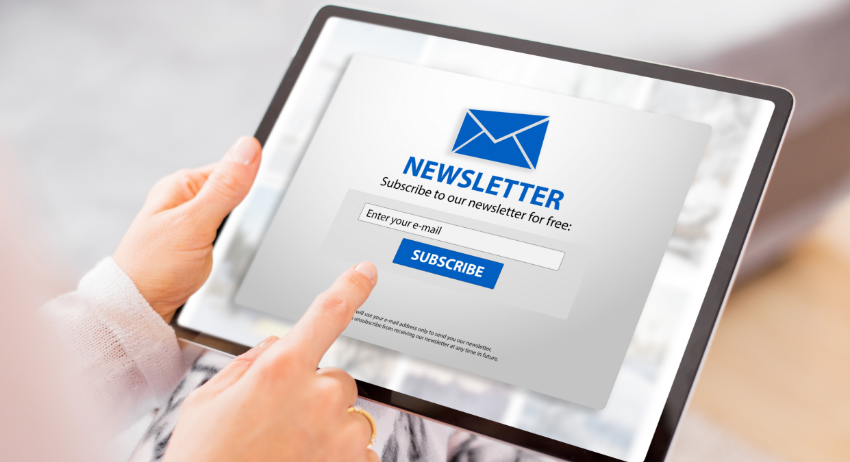Email newsletters have become a powerful tool for businesses and individuals alike to connect with their subscribers, promote their brands, and enhance customer engagement. Whether you are looking to grow your business or simply reach out to your audience, starting an email newsletter can be a game-changer. But where do you start? In this article, we will show you how to start an email newsletter in seven simple steps using HTML formatting. Let’s dive in!

1. Understanding the Basics of Email Newsletters
What is an Email Newsletter?
An email newsletter is a communication tool that is sent through email to a list of subscribers. The purpose of an email newsletter is to keep subscribers informed and engaged with the sender’s content. Email newsletters can be sent on a regular basis and can include news, updates, promotions, and other relevant information.
For businesses, email newsletters are an effective way to reach out to customers and potential customers. By providing valuable content, businesses can establish themselves as thought leaders in their industry and build trust with their audience. This can lead to increased brand loyalty and, ultimately, more sales.
Why are Email Newsletters Important?
Email newsletters are important because they allow you to reach a wider audience consistently. Unlike social media, where algorithms can limit the reach of your posts, email newsletters are delivered directly to your subscribers’ inboxes. This means that your message is more likely to be seen and engaged with.
Furthermore, email newsletters allow you to promote your brand, provide value to your subscribers, and increase customer engagement. By including links to your website and social media channels, you can drive traffic to these platforms and increase your online presence.
Another benefit of email newsletters is that they can help you track your marketing efforts. By analyzing open rates, click-through rates, and other metrics, you can gain insights into what content resonates with your audience and adjust your strategy accordingly.
Setting Your Goals and Objectives
Before starting an email newsletter, it is important to establish your goals and objectives. Your goals may vary depending on your industry and audience, but generally, your newsletter should help you achieve one or more of the following:
- Keep your subscribers informed about your brand, products, and services.
- Promote your brand and increase brand loyalty.
- Drive traffic to your website and other marketing channels.
- Increase customer engagement and conversions.
When setting your goals, it is important to keep your audience in mind. What kind of content will they find valuable? What topics are they interested in? By understanding your audience, you can create content that resonates with them and keeps them engaged.
In addition to setting goals, it is important to establish a schedule for your email newsletters. Will you send them weekly, bi-weekly, or monthly? Consistency is key when it comes to email marketing, so make sure you choose a schedule that you can stick to.
Finally, make sure you have a plan for measuring the success of your email newsletters. What metrics will you track? How often will you analyze your results? By monitoring your progress, you can make adjustments to your strategy and improve your results over time.
2. Choosing the Right Email Marketing Platform
Email marketing is one of the most effective ways of reaching out to your target audience. It is a cost-effective way of promoting your business, building relationships with your customers, and increasing your sales. However, choosing the right email marketing platform is crucial to the success of your email newsletter.
Factors to Consider When Selecting a Platform
When selecting a platform, there are several factors you need to consider. These include:
- Cost: The cost of the platform is an important factor to consider. You need to choose a platform that fits within your budget.
- User-Friendliness: The platform you choose should be easy to use. It should have a user-friendly interface that allows you to create and send emails with ease.
- Features: The platform should have all the features you need to create effective email campaigns. This includes customizable templates, automation, and analytics.
- Support: The platform should provide excellent customer support. This includes email support, phone support, and live chat support.
By considering these factors, you can choose a platform that will help you create effective email campaigns and reach your target audience.
Top Email Marketing Platforms to Consider
There are many email marketing platforms available, but some of the most popular ones include:
- Mailchimp: Mailchimp is a popular email marketing platform that is easy to use and affordable. It offers customizable templates, automation, and analytics.
- Constant Contact: Constant Contact is another popular email marketing platform that is user-friendly and offers a range of features, including customizable templates, automation, and analytics.
- AWeber: AWeber is a reliable email marketing platform that offers customizable templates, automation, and analytics. It also provides excellent customer support.
- ConvertKit: ConvertKit is a popular email marketing platform that is designed for bloggers and content creators. It offers customizable templates, automation, and analytics.
When choosing an email marketing platform, it is important to choose one that meets your specific needs. By considering the factors listed above, you can choose a platform that will help you create effective email campaigns and reach your target audience.
3. Building Your Email List
Building an email list is crucial for any business that wants to grow and succeed. It allows you to reach out to your audience directly and keep them informed about your latest products, services, and promotions. In this section, we’ll explore some effective strategies for building your email list.
Creating a Sign-up Form
A sign-up form is the first step to building your email list. It’s the gateway that allows your audience to join your list and receive your updates. When creating your sign-up form, it’s important to keep it short and simple. You don’t want to overwhelm your audience with too many questions or requests.
Your sign-up form should collect the minimum amount of information necessary to get the subscribers onto your list. Typically, this includes their first name and email address. You can use different tools to create your sign-up form, including your email marketing platform, website builder, or a plugin like OptinMonster.
Once you have your sign-up form created, it’s time to start promoting it to your audience.
Promoting Your Newsletter on Social Media
Social media is a powerful tool for promoting your email newsletter and reaching out to new subscribers. You can share links to your sign-up form on your social media profiles and encourage your audience to subscribe. You can also create social media ads to increase your reach to new subscribers.
When promoting your newsletter on social media, it’s important to provide value to your audience. You can share snippets of your latest newsletter or offer exclusive content to your subscribers. This will encourage your audience to sign up and stay engaged with your brand.
Using Lead Magnets to Attract Subscribers
A lead magnet is a valuable piece of content that you offer to your subscribers in exchange for their email addresses. Lead magnets can come in different forms, including ebooks, reports, cheat sheets, video tutorials, and more.
Using lead magnets is an effective strategy for attracting new subscribers to your email list. When creating your lead magnet, it’s important to focus on providing value to your audience. Your lead magnet should be informative, engaging, and relevant to your target audience.
Once you have your lead magnet created, you can promote it on your website, social media profiles, and other marketing channels. This will help you attract new subscribers and grow your email list.
In conclusion, building an email list is an important part of any successful marketing strategy. By creating a sign-up form, promoting your newsletter on social media, and using lead magnets to attract subscribers, you can build a strong and engaged email list that will help you grow your business.
4. Crafting Engaging Content
Creating engaging content is essential to build a loyal audience and keep them interested in your brand. In this section, we will explore the different ways you can craft content that resonates with your audience and keeps them engaged.
Understanding Your Audience
One of the most important things to consider when creating content is your audience. Understanding your audience’s pain points, interests, and preferences is crucial to create content that resonates with them. By doing so, you can build a strong relationship with your audience and keep them engaged with your brand.
One way to understand your audience is to conduct surveys or polls to gather feedback on their preferences. You can also analyze your website and social media analytics to gain insights into their behaviour and interests.
Types of Content to Include in Your Newsletter
Your email newsletter is an excellent way to keep your subscribers engaged and informed about your brand. However, choosing the right content to include can be challenging. Here are some popular types of content you can include:
- News and Updates: Keep your subscribers informed about the latest news and updates about your brand.
- Promotions and Offers: Offer exclusive deals and promotions to your subscribers to keep them interested in your brand.
- How-to Guides and Tutorials: Provide your subscribers with useful information on how to use your products or services.
- Case Studies and Success Stories: Share success stories and case studies of how your brand has helped customers overcome challenges.
- Industry Insights and Trends: Keep your subscribers informed about the latest trends and insights in your industry.
Tips for Writing Compelling Subject Lines
The subject line is the first thing your subscribers will see when they receive your email. Therefore, it is essential to craft a compelling subject line that entices them to open your email. Here are some tips for writing compelling subject lines:
- Keep it Short and Simple: Your subject line should be concise and to the point.
- Use Action-Oriented Language: Use action-oriented language to create a sense of urgency and encourage your subscribers to take action.
- Personalize Your Subject Line: Personalize your subject line by addressing your subscribers by name or using their location.
- Include a Sense of Urgency: Create a sense of urgency by using phrases such as “Limited Time Offer” or “Act Now.”
- Be Creative and Enticing: Use creative and enticing language to grab your subscribers’ attention and make them curious about what’s inside your email.
By following these tips, you can create compelling subject lines that increase your email open rates and keep your subscribers engaged with your brand.
Conclusion
Starting an email newsletter may seem daunting at first, but it is an essential tool for growing your business or engaging with your audience. By following these seven simple steps, you can create a successful email newsletter that keeps your subscribers informed and engaged. Remember, it is all about establishing your goals, choosing the right platform, building your list, crafting engaging content, and keeping your subscribers happy. Good luck!




Leave A Comment